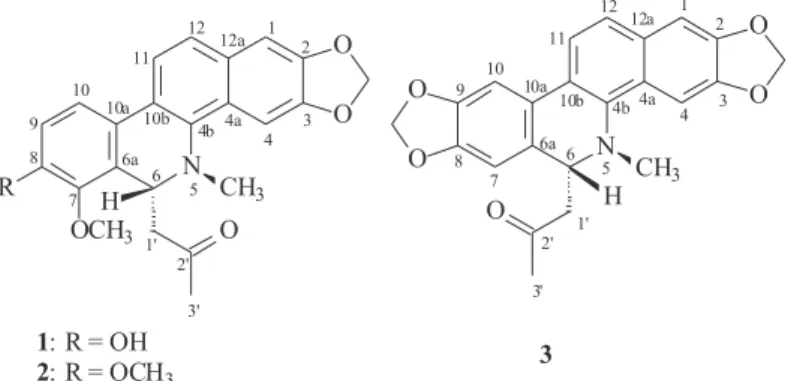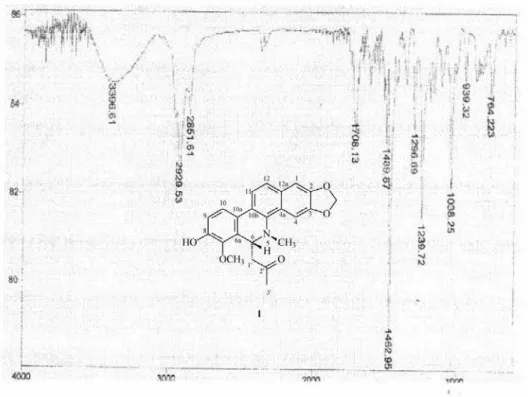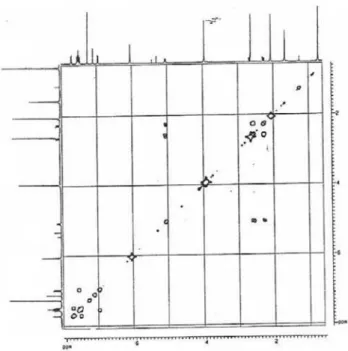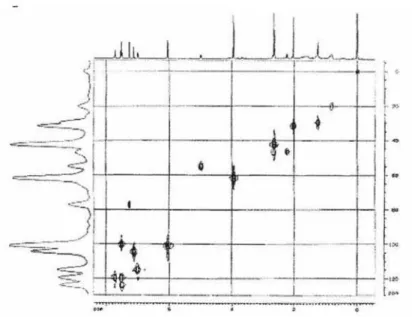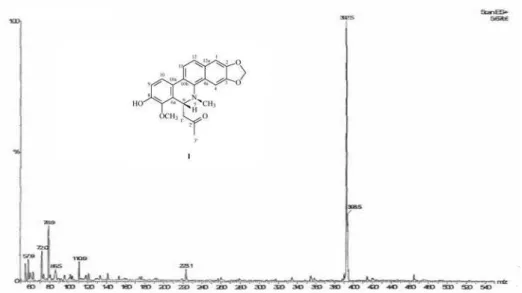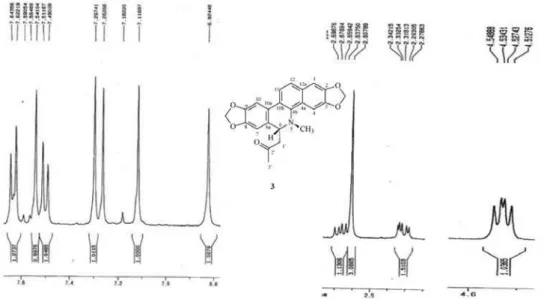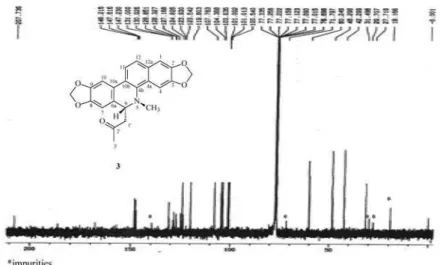S
h
o
rt
R
e
p
o
rt
J. Braz. Chem. Soc., Vol. 20, No. 2, 379-382, 2009. Printed in Brazil - ©2009 Sociedade Brasileira de Química 0103 - 5053 $6.00+0.00
*e-mail: teixeira@ufmt.br
6-Acetonyl-N-methyl-dihydrodecarine, a New Alkaloid from
Zanthoxylum riedelianum
Carromberth C. Fernandes,a Paulo C. Vieira,b Virgínia C. da Silva,c Evandro L. Dall’Oglio,c
Luiz E. da Silvac and Paulo T. de Sousa Jr.*,c
aDepartamento de Ciências da Natureza, Universidade Federal do Acre, 66915-900 Rio Branco-AC, Brazil
bDepartamento de Química, Centro de Ciências Exatas e de Tecnologia, Universidade Federal de São Carlos,
13565-905 São Carlos-SP, Brazil
cDepartamento de Química, Instituto de Ciências Exatas e da Terra, Universidade Federal de Mato Grosso,
78060-900 Cuiabá- MT, Brazil
Um novo alcalóide benzofenantridínico, 6-acetonil-N-metil-diidrodecarina foi isolado das raízes de Zanthoxylum riedelianum juntamente com lupeol, 6-acetonildiidroqueleritrina e 6-acetonildiidroavicina. As estruturas dessas substâncias foram estabelecidas com base na análise dos dados espectrométricos de IV, EM e RMN incluindo experimentos 2D.
A new benzophenanthridine alkaloid, 6-acetonyl-N-methyl-dihydrodecarine was isolated from Zanthoxylum riedelianum roots together with lupeol, 6-acetonyldihydrochelerythrine and 6-acetonyldihydroavicine. The structures were established from the IR, MS and NMR spectral data, including 2D-NMR experiments.
Keywords: Zanthoxylum riedelianum, Rutaceae, benzophenanthridine alkaloids
Introduction
The Zanthoxylum genus (Rutaceae) is composed by more than 200 species and largely distributed around
the world.1 Chemically, this genus is characterized
by alkaloids,2-7 cumarins,5,6,8 lignans,4,9,10 amides11,12
and terpenes.5,6,13,14 Ongoing studies have shown that
Zanthoxylum exhibit a range of biological activities
such as antichagas,2 tripanocidal,9 antiplasmodial,7
anti-HIV13 and antiinflammatory,8,10 as well as
anti-helmintic.12Z. riedelianum is used in folk medicine as
a decoction against different types of inflammations,
rheumatism and skin stains.15 Previous works reported
the identification of terpenes from the essential oil14
and lignans from the leaves and the stem bark.10 In this
work we report the isolation and structural elucidation of a novel benzophenanthridine alkaloid, namely,
6-acetonyl-N-methyl-dihydrodecarine (1), together with
two known alkaloids 6-acetonyldihydrochelerythrine (2)
and 6-acetonyldihydroavicine (3) from the roots of Z.
riedelianum.
Experimental
General procedures
Melting points were uncorrected. IR spectra were recorded on FTIR-Bomem-MB/100 model spectrophotometer using
NaCl film. NMR spectra in CDCl3, were recorded on Bruker
ARX-400 (400 MHz for 1H and 100 MHz for 13C); Bruker
AC-200 (AC-200 MHz for 1H and 50 MHZ for 13C) and Varian-Mercury
300 (300 MHz for 1H and 75 MHz for 13C) spectrometers,
using tetramethylsilane (TMS) as internal standard. Electron Ionization Mass Spectra (ESI-MS) was undertaken employing a Quatro LC-Micromass UK model spectrometer. Optical rotations were determined on a Perkin-Elmer 341 polarimeter. CC: silica gel (Merck 70-230 mesh ASTM); TLC:
silica gel G 60 and silica gel 60 PF254 (Merck) were used to
analyze the fractions collected from column chromatography (CC) with visualization by UV (254 and 366 nm), Dragendorff´s reagent and exposure to iodine vapor.
Plant material
6-Acetonyl-N-methyl-dihydrodecarine, a New Alkaloid fromZanthoxylum riedelianum J. Braz. Chem. Soc.
380
Grosso State, Brazil. A voucher specimen (No. 24.080) was deposited at Universidade Federal de Mato Grosso Central Herbarium.
Extraction and isolation
Dried roots (3.0 kg) were powdered and extracted with hexane and methanol by maceration at room temperature. The macerates were concentrated under reduced pressure to yield the extracts A (21.5 g) and B (200.5 g) from hexane and methanol, respectively. The extract A was partitioned with hexane, dichloromethane, ethyl acetate and methanol. Solvents were removed under reduced pressure and the dichloromethane residue (8.2 g) was submitted to column chromatography, carried out in a gradient system from hexane, dichloromethane, ethyl acetate, acetone and methanol as mobile phase. The 174 collected fractions were reunited in 30 fractions. Fraction 10 (1.0 g) afforded the triterpene lupeol (170.0 mg, mp 162.5-164.2 °C). Fraction 25 (200.0 mg) was submitted to preparative TLC with dichloromethane-methanol (2:8), affording the alkaloid 6-acetonyldihydrochelerythrine
(2, 30.0 mg, mp 171.6-173.0 °C).
The extract B was partitioned successively with hexane, dichloromethane, ethyl acetate and methanol.
The dichloromethaneresidue (530.0 mg) was submitted to
column chromatography performed in a gradient system with hexane, dichloromethane, acetone and methanol as mobile phase. The 243 collected fractions were reunited in 33 fractions after TLC comparison. Fraction 4 (190.0 mg) was submitted to preparative TLC eluting with dichloromethane-methanol (1:9), affording the alkaloids
6-acetonyl-N-methyl-dihydrodecarine (1, 60.0 mg, mp
186-188 °C) and 6-acetonyldihydroavicine (3, 57.0 mg,
mp 184-185 °C).
6-Acetonyl-N-methyl-dihydrodecarine, (1)
Brown amorphous solid. [α]D21.5º -5.625 (CHCl
3; conc.
0.014 g mL-1). IR (NaCl film) ν
max/cm
-1: 3396, 1708, 1615,
1610, 1516, 1425, 1296, 1239. 1H NMR (CDCl
3, 400 MHz)
and 13C NMR (CDCl
3, 100 MHz) (Table 1). ESIMS/MS:
m/z (rel. int.) 391 [M+H]+.
Table 1. 1H (400 MHz) and 13C-NMR (100 MHz) spectral data of 1 and 3, in CDCl3
C 1 3
dC dH (m, J in Hz) dC dH (m, J in Hz)
1 104.4 7.10 (s) 107.7 6.82 (s)
2 148.5 148.2
3 147.5 147.6*
4 100.5 7.51 (s) 103.6 7.29 (s)
4a 123.9 124.8
4b 138.8 131.0
6 54.8 5.0 (dd, 3.5, 10.9) 60.2 4.54 (dd, 5.7, 8.7)
6a 123.3 123.5
7 151.3 100.5 7.54 (s)
8 144.9 147.2
9 115.1 7.01 (d, 8.4) 147.6*
10 119.7 7.54 (d, 8.4) 104.3 7.11 (s)
10a 131.0 123.9
10b 127.5 127.1
11 120.0 7.72 (d, 8.5) 119.8 7.64 (d, 8.5)
12 124.7 7.51 (d, 8.5) 124.8 7.51 (d, 8.5)
12a 127.2 128.3
1’ (-CH2CO) 46.5 2.25 (dd, 3.5, 15.2) and 2.66 (dd, 10.9,
15.2)
48.2 2.33 (dd, 5.7, 15.7) and 2.60 (dd, 8.7,
15.7)
2’ (-COCH3) 207.6 207.7
3’(-COCH3) 31.5 2.02 (s) 31.4 1.97 (s)
OCH2O 101.1 6.05 (s) 101.1 and 101.9
6.10 (d, 2.5) and 6.0 (d, 2.5)
7-OCH3 61.9 3.95 (s)
8-OH 5.30 (s)
N-CH3 42.4 2.65 (s) 42.2 2.60 (s)
Fernandes et al. 381 Vol. 20, No. 2, 2009
Results and Discussion
The well known natural compounds lupeol,16
6-acetonyldihydrochelerythrine (2)17 and
6-acetonyl-dihydroavicine (3)18 were identified mainly by 1H and
13C NMR spectral analyses, comparing with previous
literature data.16-18
Compound 1 presented a positive test with Dragendorff´s
reagent, indicating it to be an alkaloid. The IR spectrum presented bands at 3396 (νOH), 1708 (νC=O), 1615, 1516
cm-1 attributed to aromatic rings. The positive
ESI-mass spectrum of 1 showed a quasi-molecular ion at
m/z 391 [M+H]+ pointing out to a molecular formula
C23H21NO5. The 1H NMR spectrum of 1, exhibited signals
corresponding to six aromatic hydrogen, characteristic
of a benzophenanthridine system.18 Accordingly, the
aromatic region from compound (1) 1H NMR spectrum
exhibited signals of two pairs of one-hydrogen doublets
(dΗ 7.01 (H-9) and 7.54 (H-10); 7.72 (H-11) and
7.51 (H-12)) and two one-hydrogen singlets (dΗ 7.10
(H-1) and 7.51 (H-4)) indicating the presence of four
aromatic hydrogens in ortho position and two isolated
hydrogens. The 1H NMR spectrum also displayed signals
of methylenedioxide group at dΗ 6.05 (2H, AB system),
hydroxyl group at dΗ 5.30 (s, 1H), a methoxyl group at
dΗ 3.95 (s, 3H) and the N-methyl group at dΗ 2.65 (s, 3H).
In addition to the benzophenanthridine signals, the presence of an acetonyl group at C-6 was indicated by a
methyl singlet at dΗ 2.02 and the AMX system with dΗ
2.25 (J 3.5 and 15.2 Hz) and 2.66 (J 10.9 and 15.2 Hz),
respectively, and dΗ 5.0 (J 3.5 and 10.9 Hz), corresponding
to the coupling constants between H-6 and the acetonyl
methylene hydrogens in the 1H NMR and 1H, 1H-COSY
spectra. The 13C NMR spectrum also confirmed the acetonyl
moiety with signals at 207.6 (C=O), 31.5 (COCH3), 46.5
(-CH2CO). Through the chemical shifts observed in the
13C, 1H-gHSQC spectrum, it was possible the attribution
of each carbon and its respective hydrogen (Table 1). The cross peaks observed in the HMBC spectrum showed
long-range couplings from H-6 (dΗ 5.0) and H-3’ (dΗ 2.02) with
C-2’ (dC 207.6), confirming the connection of the acetonyl
moiety with C-6. Further correlations were observed
between OCH3 (dΗ 3.95) with C-7 (dC 151.3), as well as H-9
(dΗ 7.01) and H-10 (dΗ 7.54) with C-8 (dC 144.9) and C-10
(dC 119.7), indicating that position 8 is substituted; finally,
N-CH3 (dΗ2.65) with C-6 (dC 54.8). The absence of the
methoxyl group in C-7 moves away the effect of the oxygen
atom in C-6, justifying its largest chemical shift (dC 60.2)
in compound 3, when compared with the correspondent
dC 54.8, attributed to C-6 in compound 1; thus revealing
∆C = 54.9-60.2 = -5.3 ppm as γ effect. Therefore, the
structure of 1 was established as 6-acetonyl-N
-methyl-dihydrodecarine, a decarine derivative.18 Previous
publications,17,18 however, reported the isolation of the
unstable parent alkaloids avicine and nitidine. Although acetone derivatives of avicine and nitidine have been reported in the literature,19-21 as well as acetone aducts
of two other benzophenantridine alkaloids,22,23 it is
controversial, however, whether those acetone derivatives are really present on the plant extract or were isolated as artifacts, due to the greater stability of the acetone aducts as compared to the parent alkaloids avicine and nitidine.
Acknowledgments
The authors are grateful to CNPq, FAPEMAT and Centro de Pesquisa do Pantanal (CPP) for scholarships and financial support, as well as to Dr. A. Gilberto Ferreira, UFSCar, for the 400 MHz NMR spectra.
Supplementary Information
Supplementary data of alkaloids structures as 1 and
2D 1H and 13C NMR spectra are available free of charge at
http://jbcs.sbq.org.br, as PDF file.
References
1. Talapatra, S. K.; Dutta, S. K.; Talapatra, B.; Phytochemistry
1973, 12, 729.
2. Ferreira, M. E.; Nakayama, H.; Arias, A. R.; Schinini, A.; de Bilbao, N. V.; Serna, E.; Lagoutte, D.; Soriano-Agatón, F.; Poupon, E.; Hocquemiller, R.; Fournet, A.; J. Ethnopharmacol.
2007, 109, 258.
3. Hu, J.; Zhang, W. D.; Shen, Y. H.; Zhang, C.; Xu, L.; Liu, R. H.; Wang, B.; Xu, X. K.; Biochem. Syst. Ecol.2007, 35, 114. 4. Rahman, M. M.; Islam, M. A.; Khondkar, P.; Gray, A. I.;
Biochem. Syst. Ecol. 2005, 33, 91.
5. Arruda, M. S. P.; Fernandes, J. B.; Vieira, P. C.; da Silva, M. F. G. F.; Pirani, J. R.; Biochem. Syst. Ecol.1992, 20, 173. 6. Oliveira, E. L.; Freitas, P. C.; Guedes, M. L. S.; Velozo, E. S.;
Rev. Bras. Farmacogn.2002, 12, 29.
7. Jullian, V.; Bourdy, G.; Georges, S.; Maurel, S.; Sauvain, M.;
J. Ethnopharmacol.2006, 106, 348.
8. Chen, I. S.; Lin, Y. C.; Tsai, I. L.; Teng, C. M.; Ko, F. N.; Ishikawa, T.; Ishii, H.; Phytochemistry 1995, 39, 1091. 9. Bastos, J. K.; Albuquerque, S.; Silva, M. L. A.; Planta Med.
1999, 65, 541.
10. Lima, L. M.; Perazzo, F. F.; Carvalho, J. C. T.; Bastos, J. K.; J. Pharm. Pharmacol. 2007, 59, 1151.
11. Chen, I. S.; Chen, T. L.; Lin, W. Y.; Tsai, I. L.; Chen, Y. C.;
6-Acetonyl-N-methyl-dihydrodecarine, a New Alkaloid fromZanthoxylum riedelianum J. Braz. Chem. Soc.
382
12. Navarrete, A.; Hong, E.; Planta Med.1996, 62, 250. 13. Cheng, M. J.; Lee, K. H.; Tsai, I. L.; Chen, I. S.; Bioorg. Med.
Chem.2005, 13, 5915.
14. Guy, I.; Charles, B.; Guinaudeau, H.; Ferreira, M. E.; Arias, A. R.; Fournet, A.; Pharm. Biol.2001, 39, 152.
15. Guarim Neto, G.; Plantas Utilizadas na Medicina Popular do Estado de Mato Grosso, Associação Brasileira de Educação Agrícola Superior: Brasília, 1996.
16. Mahato, S. B.; Kundu, A. P.; Phytochemistry1994, 37, 1517. 17. Julián, A.; Delgado, G.; Rev. Soc. Quim. Mex. 2001, 45, 189. 18. Nissanka, A. P. K.; Karunaratne, V.; Bandara, B. M. R.; Kumar,
V.; Nakanishi, T.; Nishi, M.; Inada, A.; Tillekeratne, L. M. V.; Wijesundara, D. S. A.; Gunatilaka, A. A. L.; Phytochemistry
2001, 56, 857.
19. Arthur, H. R., Hui, W. H.; Ng, Y. L.; J. Chem. Soc. 1959, 4007.
20. Gopinath, K. W.; Kohli, J. M.; Kahn, M. S. Y.; Kidwai, A. R.;
Indian J. Chem. 1963, 1, 99.
21. Fotie, J.; Bohle, D. S.; Olivier, M.; Gomez, M. A.; Nzimiro, S.;
J. Nat. Prod. 2007, 70, 1650.
22. Desai, P. D.; Govidachari, T. R.; Nagarajan, K.; Visvanathan, N.; Indian J. Chem.1967, 5, 41.
23. Ng, K. M.; Gray, A. I.; Waterman, P. G.; Phytochemistry1987,
26, 3251.
Received: December 5, 2007 Web Release Date: December 12, 2008
S
u
p
p
le
m
e
n
ta
ry
In
fo
rm
a
ti
o
n
J. Braz. Chem. Soc., Vol. 20, No. 2, S1-S7, 2009. Printed in Brazil - ©2009 Sociedade Brasileira de Química 0103 - 5053 $6.00+0.00
*e-mail: teixeira@ufmt.br
6-Acetonyl-N-methyl-dihydrodecarine, a New Alkaloid from
Zanthoxylum riedelianum
Carromberth C. Fernandes,a Paulo C. Vieira,b Virgínia C. da Silva,c Evandro L. Dall’Oglio,c
Luiz E. da Silvac and Paulo T. de Sousa Jr.*,c
aDepartamento de Ciências da Natureza, Universidade Federal do Acre, 66915-900 Rio Branco-AC, Brazil
bDepartamento de Química, Centro de Ciências Exatas e de Tecnologia, Universidade Federal de São Carlos,
13565-905 São Carlos-SP, Brazil
cDepartamento de Química, Instituto de Ciências Exatas e da Terra, Universidade Federal de Mato Grosso,
78060-900 Cuiabá- MT, Brazil
6-Acetonyl-N-methyl-dihydrodecarine, a New Alkaloid fromZanthoxylum riedelianum J. Braz. Chem. Soc.
S2
Figure S2. 1H NMR spectrum (400 MHz, CDCl
3) of 1 (6-acetonyl-N-methyl-dihydrodecarine).
Figure S3. Expansions of the 1H NMR spectrum (400 MHz, CDCl
Fernandes et al. S3 Vol. 20, No. 2, 2009
Figure S4. 1H,1H, COSY spectrum (400 MHz, CDCl
3) of 1 (6-acetonyl-N-methyl-dihydrodecarine).
Figure S5. 13C NMR spectrum (100 MHz, CDCl
6-Acetonyl-N-methyl-dihydrodecarine, a New Alkaloid fromZanthoxylum riedelianum J. Braz. Chem. Soc.
S4
Figure S6. gHSQC spectrum (100 MHz, CDCl3) of 1 (6-acetonyl-N-methyl-dihydrodecarine).
Fernandes et al. S5 Vol. 20, No. 2, 2009
Figure S8. EIMS (+) of 1 (6-acetonyl-N-methyl-dihydrodecarine).
6-Acetonyl-N-methyl-dihydrodecarine, a New Alkaloid fromZanthoxylum riedelianum J. Braz. Chem. Soc.
S6
Figure S10. 1H NMR spectrum (400 MHz, CDCl
3) of 3 (6-acetonyldihydroavicine).
Figure S11. Expansions of the 1H NMR spectrum (400 MHz, CDCl
Fernandes et al. S7 Vol. 20, No. 2, 2009
Figure S12. 13C NMR spectrum (100 MHz, CDCl
3) of 3 (6-acetonyldihydroavicine).
Figure S13. gHSQC spectrum (100 MHz, CDCl3) of 3 (6-acetonyldihydroavicine).
